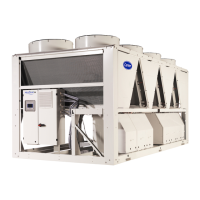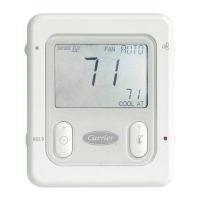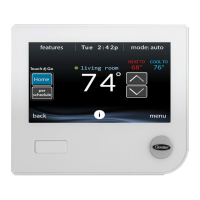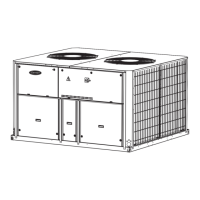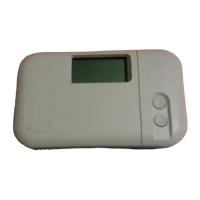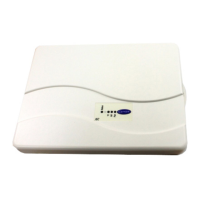compressor capacity is 100%, the valve is continually
adjusted to maintain the supply air temperature to
heatcool submaster reference. In cooling mode this valve is
kept fully opened (completely bypass the hot-water
system). If the unit is heat pump, the valve is kept closed
during defrost sequences (hot-water system feed).
6.20 –Pre-heating Option Control
This option is used to maintain mixed air temperature
between 10 and 11°C.
First the pre-heater option has to be selected and an
economizer is needed. This option is also working with a
thermistor before air filter to measure mixed air temperature.
The electrical pre-heaters shall be turned ON when unit
needs to do heating or standby providing that the economizer
is at its minimum configured position and shall be turned OFF
when the unit needs to do cooling
.
6.21 – Economizer
The unit may control an economizer which is activated to
enable fresh air to be fed in from outside when conditions
permit (this is called free cooling). The controller uses two
loops in tandem to control space temperature with the aid
of the economizer. The external loop calculates the supply
air temperature required to maintain space temperature at
space control point. The internal loop determines the
economizer position needed to maintain this supply air
temperature.
For unit with THR option, when THR compressor is
running, economizer damper shall be modulated to
guarantee enough fresh air pass through the THR
exchanger for safe function of THR.
Special conditions:
•
The economizer shall be kept closed when the unit is
stopped.
•
The economizer shall be held at its minimum position of
15% (this value may be configured by Carrier Service)
when:
- The unit is in heating mode
- Space temperature is below space control point
- The difference between space temperature and outdoor
temperature is less than the economizer utilisation
threshold (i.e. a value of 7 K which may be configured by
Carrier Service)
- Blower temperature is below 10°C
- The unit is fitted with an outside air enthalpy sensor and
this is indicating a high enthalpy which is incompatible with
feeding in air from outside.
•
The economizer shall be kept fully open when purge
mode is active.
•
The minimum position of the economizer shall be
altered in order to meet air quality requirements (see
section 5.18 - “Controlling air quality”).
•
If the system embeds the VAV option, the fresh air rate is
calculated as a function of the economizer damper position.
Thus the minimum position of economizer depends on the
minimum authorized value for fresh air ratio.
•
The minimum position of the economizer shall not
exceed 25% if the outdoor temperature is below 6°C.
i.e. when OAT < 6°C
- If the configured economizer minimum position >25%, the
economizer minimum position is 25%.
- If the configured economizer minimum position is <25%
(e.g. 5%), the economizer minimum position is 5%.
•
If the outdoor temperature is below 15°C, all compressors
shall be stopped and only free cooling shall be authorised.
If the unit is fitted with a power exhaust fan this shall be open if
the position of the economizer is in excess of 50% (this
threshold may be modified by Carrier Service).
6.22 – Purge
This function can only be used if the unit is fitted with an
economizer. When the unit switches from unoccupied to
occupied mode, the economizer is kept fully open for two
minutes provided the outdoor temperature is between 10°C
and 21°C. A purge will not be activated if the occupied
period is intended to last less than two hours. This function
must be validated by the user in the GENCONF menu. It is
also possible to alter the length of the purge and the limiting
outdoor temperatures in the Setpoint menu.
6.23 – Controlling air quality
This function is used if the unit is fitted with an air quality
sensor and an economizer. With the aid of a PI function, it
enables the position of the economizer to be continually
adjusted in order as far as possible to maintain air quality at
its setpoint whilst preventing the space temperature from
drifting too greatly (in view of the fact that the heating or
cooling stages are not authorised to operate at this point).
On the other hand if the error in the heating or cooling
space setpoint being maintained exceeds 2.2°C, this function
is disabled and the economizer returns to its minimum
configured position (30%), and the heating or cooling
stages are authorised to operate again. Air quality control
cannot then be authorised for another hour. This function
is not active in unoccupied mode.
6.24 – Master/slave assembly
Up to 6 units can take part in a master/slave assembly. This
group then constitutes a zone in which conflicting states of
cooling/heating are not allowed between units. The master
unit determines the cooling or heating mode for the zone.
If one of the slave units is in a different cooling/heating
mode from the master unit, the unit concerned is switched to
ventilation mode without producing heat or cooling. This
function is not active in the frost protection mode.
The function operates under all operating types. It requires the
use of a communication bus between the units concerned
and must be configured by Carrier Service.
6.25 – Fire protection
When the normally closed smoke detection contact is open,
the unit is shut down and either the fire output is activated
or the economizer damper is opened.
6.26 – Energy recovery module (ERM)
This function can only be used if the unit is ftted with an
economizer and return fan. The ERM option is used to
save energy by recovering heat or cool energy air from the
exhaust air and supplying that energy to the outside air passing
through a metal recovery wheel in the rooftop unit.
The principle is based on exhaust air and outside air passing
through a rotating wheel. The exhaust air temperature is about
20°C.
Locally in the exhaust air duct, the wheel temperature changes to
the exhaust air temperature. The wheel rotates and outside air
passes through the wheel. The wheel supplies the energy
recovered from exhaust air back to the inlet air.
The ERM wheel is working according to four situations:
1. Recirculation mode: Economizer is off for air recycling,
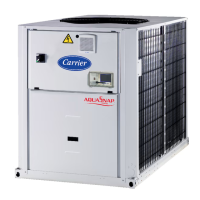
